Stories & memories
Twyford New School
In 1987 a hard-fought battle to save our village school from closure was successfully won by the residents.
TV actor and Play School presenter, Fraser Wilson, found himself chair of the action group ably assisted by the local Buckingham MP, George Walden.
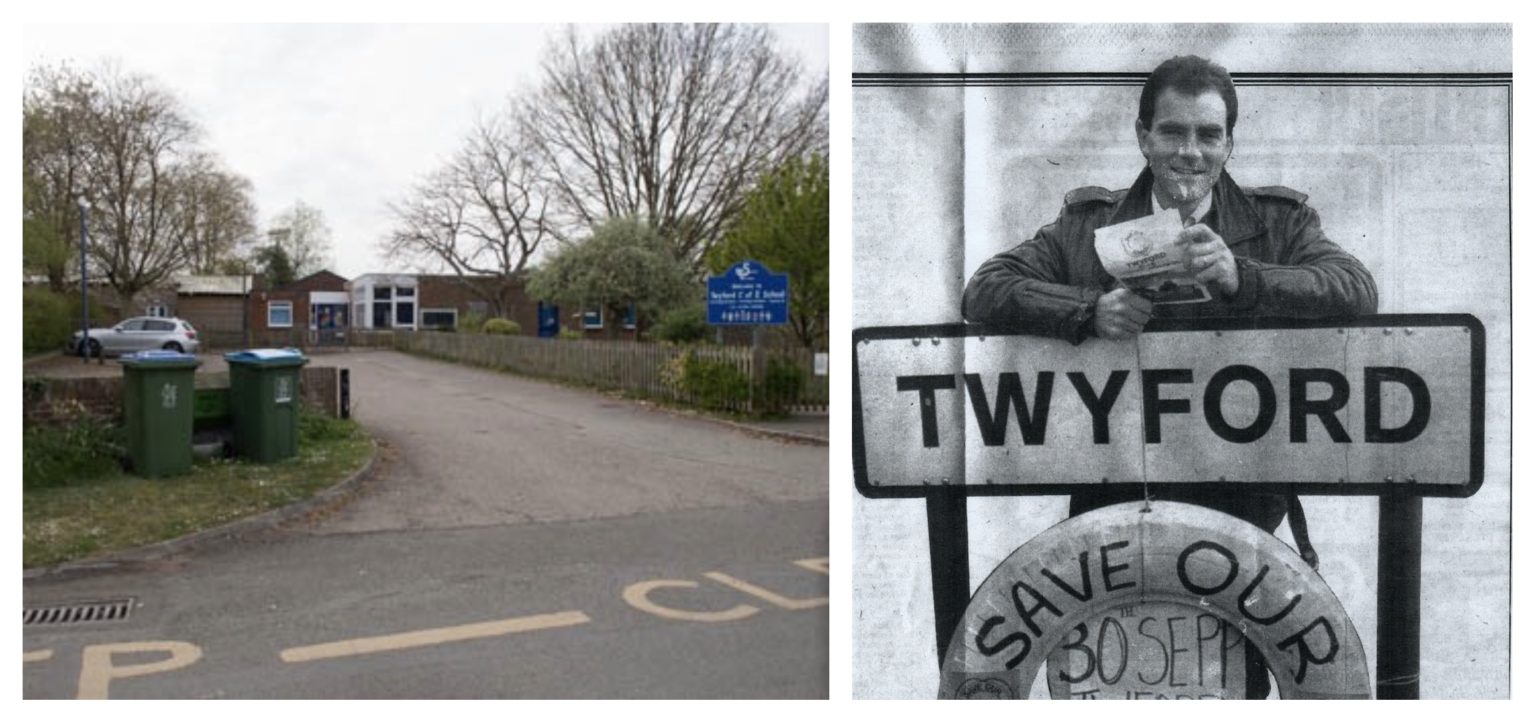
Twyford Church Bells
In November 1981, the landlord of the Red Lion pub in Church Street, Colin Thompson, lost his court battle with Twyford Parish Council to get an injunction to silence the clock chimes between 11.00pm and 8.00am.
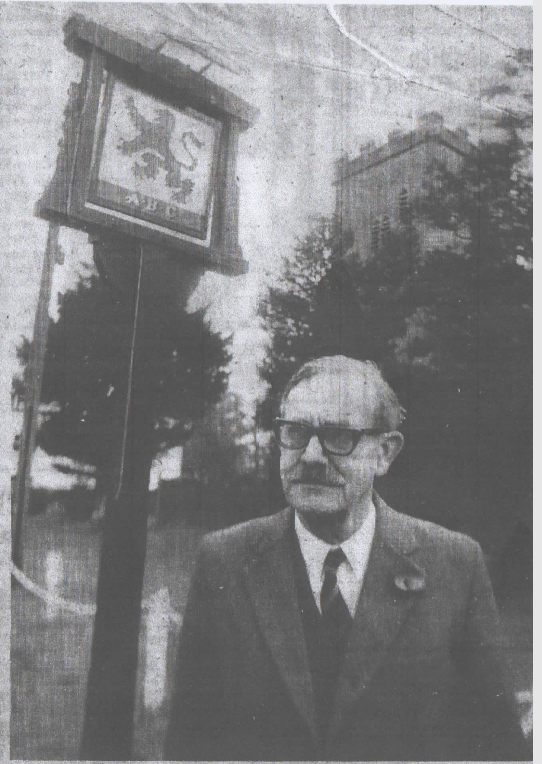 The villagers had raised funds to enable the clock chiming mechanism to be brought back into service as a commemoration.
The villagers had raised funds to enable the clock chiming mechanism to be brought back into service as a commemoration.
Twyford Village Hall was turned into a courtroom for the five day hearing and most days, the hall was packed with local residents and British and American TV crews and national press.
Mr Thompson moved to the village in 1975 when, he claimed, the bells were silent.
His bedroom windows are right opposite the church bell tower and they were ringing the Westminster Chimes for 24 hours a day preventing him getting a night’s sleep.
Sheep Stealing
On 19th Oct 1839, a trial was held at Bucks Middlemass Sessions of Edward Hall aged 37 and Joseph Hill aged 31, both of Twyford. They had been accused of stealing a sheep from Mrs Innes of Preston Bissett.
Mrs Innes’s nephew, William Watt, who looked after her sheep, had noticed one was missing and there was evidence of a sheep having been killed. He found the skin, head and two feet and knew it belonged to Mrs Innes as it had particular marks on the head.
He went to Buckingham and borrowed a bloodhound. The dog traced the scent of the sheep back to the house of Joseph Hill in Twyford Close and along with his neighbour, Mr Harper, they searched the property. In the pond, the bloodhound found a piece of mutton that was still warm.
They searched Hill’s house and examined the boiler; mutton had recently been boiled; it was greasy. Afterwards, they went with Hill to Kinch’s Close and in a bog, they found Hill’s clothes which were bloody
The two accused confessed to stealing the sheep and were sentenced to 15 years transportation to Australia. Their families suffered hardship as a result of losing the breadwinners and spent some time in the workhouse in Buckingham.
Convict Ships were used to transport criminals to Australia and the first such ship sailed in 1787 which was only 17 years after Captain Cook discovered “Terra Australis Incognita” in his ship the Endeavour in 1770.
Convicts were held in hulks (old redundant ships) for months until they had a fleet full. Often the only exercise was the treadmill from which many fell to their death.
JOSEPH HILL
Joseph Hill was illiterate, protestant, married with 3 female children, 5’5½” tall, dark ruddy complexion, brown hair, grey eyes, nose cocked, scar over left eyebrow, another on left side of chin, breast hairy, scar back of little and forefingers of left hand.
He was deported on HMS Maitland which sailed on 19th March, 1840
Arrived 14th July, 1840 at New South Wales
Average sentence: 11 Years | Life sentences: 43 | Passengers: 306
Joseph obtained a conditional pardon and arrived in Sydney in 1840 and was admitted to Darlinghurst jail in 1842. He received his Ticket of Leave in 1846 and lived in the Yass area at that time. He would not have been able to return to England.
Joseph’s family:
Joseph married Sarah Harraway on 9 February 1833 in Caversfield, she was born in Newton Longville. They had three daughters – Elizabeth born 1833, Ann born 1835 and Hannah born 1838. Little is known about Elizabeth but Hannah remained single and was recorded as a resident of Buckingham Workhouse in the census returns of 1861 and 1871 when her occupation was listed as Lacemaker. Unfortunately, Hannah died in December 1877 at the age of just 39.
Joseph’s second daughter, Ann, lived in Leckhamstead in 1861 working as a servant but returned to live in Twyford after marrying Thomas Cross, on 28 April 1864, when she was 29. In the 1861 and 1871 census returns, Thomas’s occupation was listed as a Blacksmith, assisting his father in his blacksmith’s shop.
1871 census Ann and Thomas had a son, Edward W, born 19 March 1865. A daughter Elizabeth Sarah was born in 1874 but sadly Thomas died in 1875 at the age of 38 whilst Ann was pregnant with a son – Thomas (jnr) born 1876.
Joseph’s wife, Sarah, died in December 1866 at the age of 60.
EDWARD HALL
Edward Hall was one of 276 convicts transported to Australia on the HMS Asia on 25 April 1840
Arrived 6th August, 1840 at Van Diemen’s Land
Average sentence: 12 Years | Life sentences: 18 | Passengers: 276
In custody – good disposition. Hulk report orderly
Edward would have had a hard time in Van Diemen’s Land (now Tasmania). On 11 November 1841 he was sent to Fingal penal colony, one of the hardest penal colonies, a terrible and harsh place at the time. It was unusual for someone like Edward to be sent to Van Diemen’s Land as usually it was only repeat offenders, escapees or murderers who were imprisoned there. In reports he was described as industrious, inoffensive and good. However, in November 1842 he was charged with misconduct, having ridden across Mr Cope’s growing crop of wheat and abusing his servants; he was subsequently sentenced to three months hard labour.
In November 1849 he was able to obtain a conditional pardon under the proviso the ex-convicts didn’t leave Australia, the prisoners were never allowed to return to England. – as they had been pardoned in Australia and not in England. The pardon allowed the people to be free, purchase land earn a living.
Edward died in 1851, aged 49, with inquest findings that he committed suicide. He was buried in Mudgee New South Wales.
Below is a transcript of the Inquest into Edward’s death.
An Inquisition indented taken for our Sovereign Lady the Queen at the House of Henry Sullivan known by the sign of the Robert Burns at Launceston in the county of Cornwall within the Island of Van Diemen’s and this twenty third day of July in the fifteenth(?) year of the Reign of our Sovereign Lady Victoria by the Grace of God of the United Kingdom of Great Britain and Ireland Queen Defender of the Faith before me Michael KennedyEsquire one of the Coroners of our said Lady the Queen for the said Island and its Dependencies on view of the Body of Edward Hall then and there lying dead upon the Oaths of Thomas Cox George Ludlow John Hopwood James Tremble George Bushby Ephraim Digby and John Selby good and lawful men of the said Island and duly chosen and who being then and there duly sworn and charged to enquire for our said Lady the Queen when where how and after what manner the said Edward Hall Came to His death do upon their Oath say THAT the said Edward Hall on the twenty second day of July in the year aforesaid with force and arms at Launceston aforesaid in the County aforesaid in and upon himself feloniously wilfully and of his malice aforethought did make an assault and that the said Edward Hall with a certain gun charged with gunpowder and certain that which he the said Edward Hall in his right hand then and there had held feloniously wilfully and of his malice aforethought to and against the head of him the said Edward Hall did then and there shoot off of his malice aforethought discharge and that the said Edward Hall with the shot aforesaid the gun aforesaid in and upon the head of him the said Edward Hall then and there feloniously wilfully of his malice aforethought did strike wound and penetrate then and there giving unto himself the shot aforesaid so as aforesaid discharged and shot out of the gun aforesaid by the force of the gunpowder to the said Edward Hall then and there instantly died And so the Jurors aforesaid upon their Oath aforesaid do say that the said Edward Hall wilfully and of his malice aforethought did kill and murder himself against the peace of our said Lady the Queen her Crown and dignity in the manner and by the means aforesaid feloniously.
IN WITNESS when of as well the said Coroner as the Jurors aforesaid have to this Inquisition set their Hands and Seals the day and year and place above mentioned.
M Kennedy Coroner
Thomas Cox Foreman
George Ludlow X his mark John Hopwood James Tremble
George Bushby Ephraim Digby John Selby
Edward’s family:
Edward’s wife was Mary Dewberry whom he married on 23 February1829 at Steeple Claydon. The couple had four children – Joseph born 1830, Ann born 1835, Thomas born 1838 and Francess born 1839.
The 1841 census shows Mary living in Twyford with her four children and she is described as a pauper. In 1851 she is living with her two younger children, Thomas and Francess and her occupation is noted as “parish relief”. There is no record of Mary after the 1851 census and as her daughter Ann stated “mother dead” in 1856 it is assumed that she passed away in the early 1850s.
Joseph is listed in the 1861 census as a 31 year old labourer living in West Bromwich and married to Sarah, aged 28 from Wolvercote, Oxfordshire. They have a niece called Mary Spencer living with them. By 1901 Joseph and Sarah had moved back to Wolvercote. In 1911 he was a widower and died in 1917 at the age of 87 years old.
Ann Hall, aged 16, was listed in the 1851 census living in Swanbourne and working as a servant for John Coleman, farmer.
In 1856 Ann was listed on the passenger list of the “Morayshire” travelling to Australia. She has a “calling” described as a Dairymaid and plain cooking and was able to read. Her parents are recorded as “Edward and Mary – ‘father living’ ‘mother dead’. (Ann was obviously unaware of her father’s demise). It is also recorded that she has no relatives in the colony. She had paid £1 to the immigration board. It appears that she met a fellow passenger – John Webb age 20 from Ickelton, Cambridgeshire who was travelling alone and had also paid £1 for his passage.
Ann and John Webb were married in Cooks River, New South Wales in July 1858 and their son George was born in 1870 and he was followed by two further sons and one daughter.
Ann died on 31 October 1901 at Lockwood, Molong district of New South Wales from cancer of the stomach. The obituary notice in the Molong Argus described Ann as “widely and respectfully known throughout the district ……her loss to Lockwood will be severely felt as she as ever ready and willing, in times of sickness and suffering, to render assistance where required and her services were of inestimable value”.
Ann’s widower husband John Webb died in March 1915, as a result of burns. John was a heavy smoker and a pipe, matches and tobacco were found on the floor near the bed, which had caught fire.
Thomas Hall was recorded in the 1871 census as living at 94 Park Street, Darlington as a boarder at the home of his sister Fanny (Francess) and her husband Edmund Cox. Thomas was aged 33 and a general labourer. He was unmarried and still living in Darlington with Francess and Edmund in 1881 but in 1891 he was living at 9 Bridge Street Darlington with his wife Mary, stepson John Whittaker and granddaughter Mary.
Francess Hall married Edmund Cox from Preston Bissett in August 1859 at the age of 20. In 1861 the couple had moved to Darlington and in 1881 they are recorded as having 3 sons and a daughter.
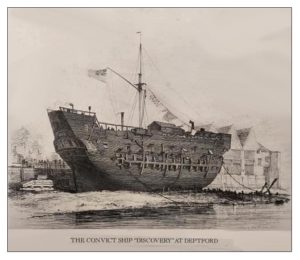
Memories of Twyford Morris
by Peter Taylor
The first performance of Twyford Morris was at an event called Midsummer Madness that took place in 1979 in Twyford Village Hall. The history of Twyford Morris mark 2 starts from there – I call it mark 2 because I researched Morris Dancing in our area at Cecil Sharpe (CS) house in London and turned up some interesting stuff in the archives. CS travelled the country in the late 19th/ early 20th century and collected and recorded folk songs and folk dances before they died out. He writes about visiting Twyford and meeting an old lady called Ayres (old village name) who remembered that in the 1850s Twyford had a Morris side that used to travel around the villages dancing for beer and a bed.
Apparently, so the story goes, they all finished up one night in Marsh Gibbon and had to sleep eight to a bed. CS also recorded a Steeple Claydon dance music, but no steps were recorded. Apparently at that time, unemployment was rife and the local farmers clubbed together to pay for the young men to go to America to find a new life, so Morris died out.
For the Midsummer Madness evening, 6 of us blokes were taught a rapper sword dance by a chap from Thornborough, near Buckingham. We mocked up some twee bells and attempted to look a bit like Morris dancers. In the audience was a friend of Jane Morgan called Bob Shakeshaft. Bob was squire of Stony Stratford Morris and said to me “don’t make fun of Morris, come and learn to do it properly”, so I did. I, and occasionally Martin Whittam when he could make it, joined them for their weekly winter training sessions and learned two dances: Queen’s Delight, from Bucknell, and Constant Billy, from Longborough. I then brought those back to the village and set up Twyford Morris. The side at that time, from memory, was Martin Whittam, John Bristow, Eddie Ridge, Neil Moreton, Alan Dodd, Jim Munn, Nick Thorne and myself. Our first outing was a fete on Charndon recreation ground, using taped music. Musicians came later!
In the early days we were helped by a melodeon player from Akely Morris who lived in Thornborough. Can’t remember his name. Our first proper musician was a guy called Stan Tallack, a melodeon player from Steeple Claydon. Stan played for us for a couple of years then sadly died suddenly from an asthma attack. He was followed by Chris Spalding, a mandolin player, who played for us for many years.
We danced at several local fetes, and regularly danced out at pubs in the summer evenings. Our most bizarre event was at the Rank Xerox annual dinner dance at the Heathrow Hilton, it was a very posh affair, and we shared the performance floor with the band of the Grenadier Guards! Eddie was a very senior executive at Rank Xerox, and our arrival was a surprise and the subject of some puzzlement until the gradual recognition of Eddie as part of the side brought the house down.
In about 1983 or 1984, we were struggling to keep going, as one or two dropped out so we decided to invite ladies into the side. Sally Williams from Poundon and Rae Sloane and Lizzy Boardman from Twford joined us. That made one or two purist die-hards leave us, but it was the right decision and the side grew as Michele Allen and Linda Wildman added to the numbers.
I’m not sure now how it all came to an end. Our last musician was a lady from Marsh (I think) and when she left, we couldn’t find a replacement. Geoff and Linda joined up with another side (Owlswick) and with no musician, so the side died, to be revived now and then for the odd special event…
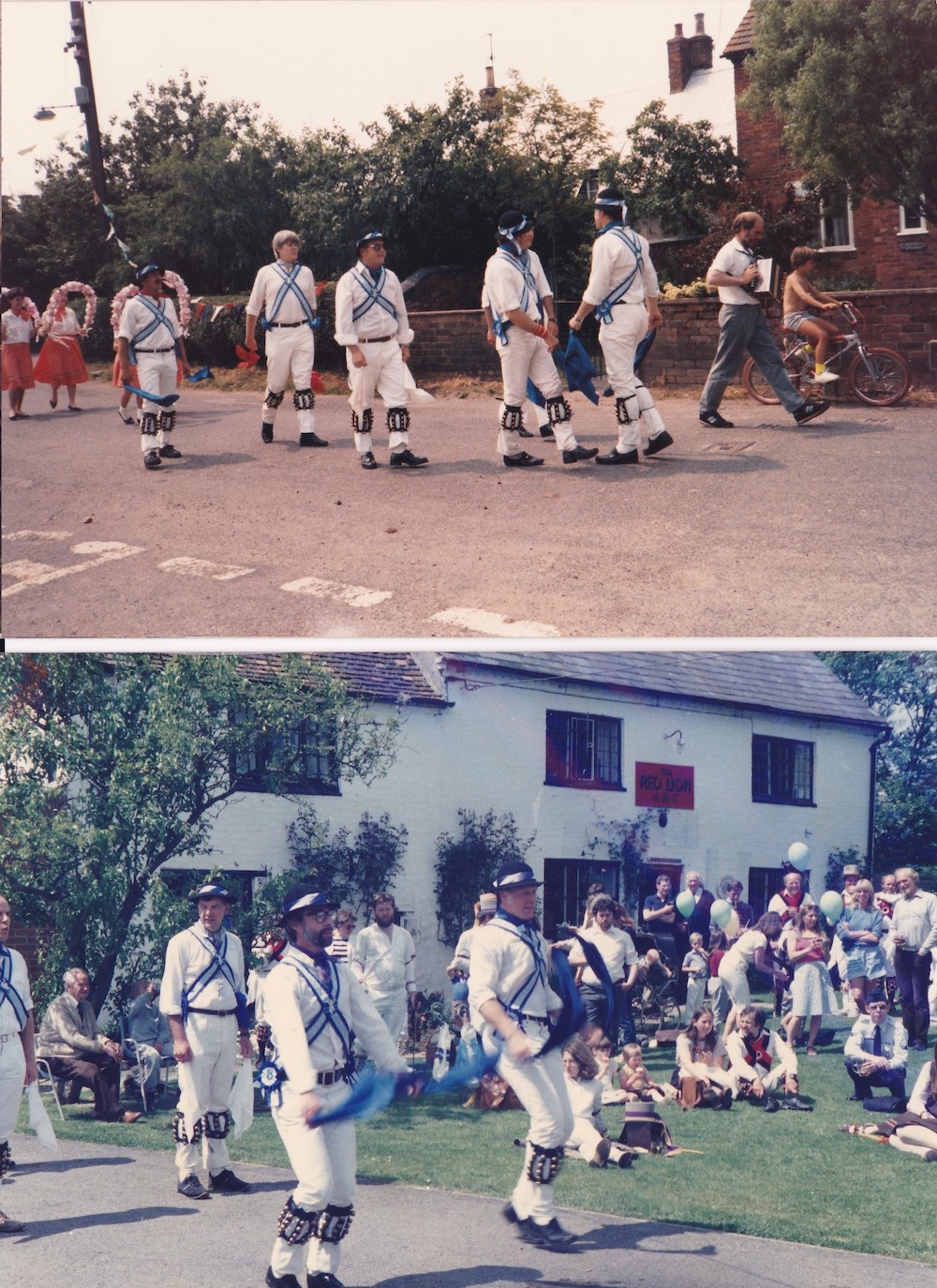
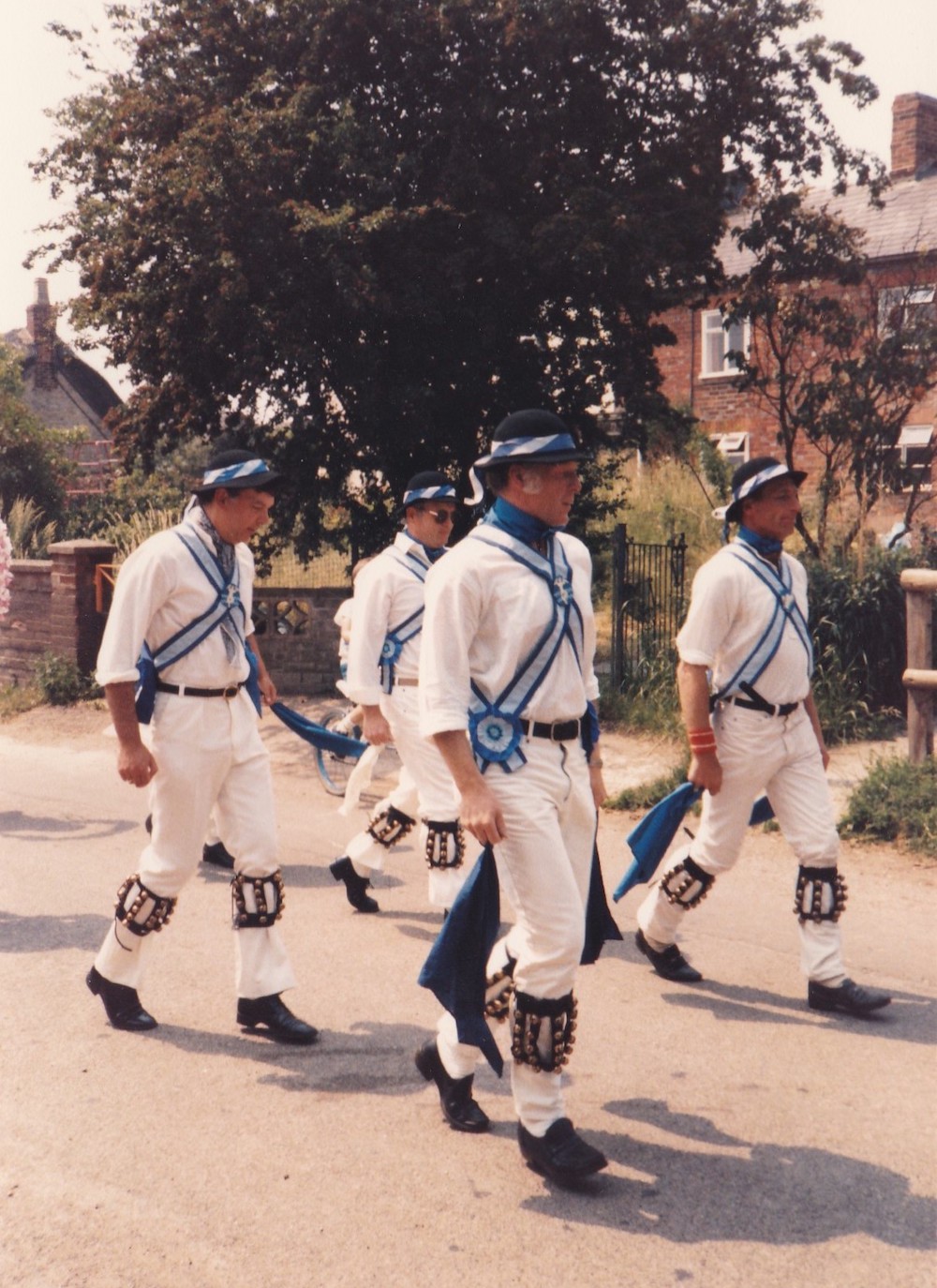
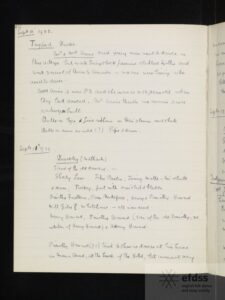
Sept 10 1922
Twyford Bucks
Mr and Mrs Ariss (census 1911, probably Mary and William Aris who were living in Bicester Road) said young men used to dance in this village but work being slack, families clubbed together and sent several of them to America – no one now living who used to dance.
Mrs Ariss who is now 82 and she was 10 or 12 when they last danced. Mr Ariss thinks no Morris since railway built.
Bells on legs and five? (Fine) ribbons on their sleeves and shirts. Bells on arms as well (?). Pipe and drum
Copies of documents in the Vaughan Williams Memorial Library https://www.vwml.org/search ‘Twyford Bucks’
Twyford Morris 1852.
George Hall, Foreman, 38, Farm Labourer, Born Twyford (living in ‘97)
James Tombes, 35, Deaf and Dumb, Born Twyford
Th Culley
Wm Wise
John Wise, Farm Labourer, Twyford
John Allen, Carpenter, 28, Born Twyford
W Little.
Thomas Wise, Squire, 65 Farm labourer, Born Twyford
H Edwards. These all slept in one bed at Gottington, 3 at the head and 3 at the foot. The Squire kept guard.
T. Y. C
